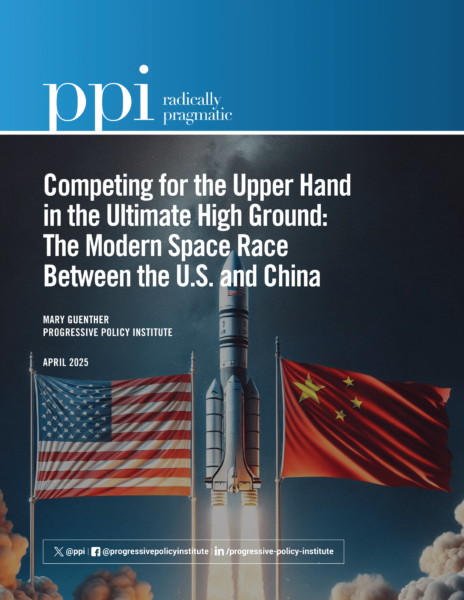FACT: Five-eighths of U.S. imports are “business inputs,” three-eighths “consumer goods.”
THE NUMBERS: Imports of U.S. goods by type, 2024 –
| U.S. GDP. 2024 |
$29.185 trillion |
| All goods imports: |
$3.270 trillion |
| Consumer goods: |
$1.225 trillion |
| “Capital goods”: |
$1.113 trillion |
| “Intermediate” goods: |
$0.534 trillion |
| “Raw materials”: |
$0.327 trillion |
WHAT THEY MEAN:
Reviewing the likely effects of this month’s Trump administration tariffs on the U.S. space industry this week, PPI space expert Mary Guenther has a blunt warning:
“The ever-evolving tariff regime … will raise the cost of making rockets and satellites in the U.S., limit industry access to core inputs and materials, and encourage boycotts of American products and services abroad.”
Some background, then we can place her judgment against the administration’s view that tariffs mean ‘more manufacturing industry’:
The Trump administration’s “reciprocal” tariff system launched at midnight last Wednesday. Greeted icily by the stock and bond markets the next morning, it lasted about 5½ hours before “pausing” just after lunch. It and may or may not resurface in July. The April 2 decree which created it, though, imposed not one but two new tariff systems. The second is still in place, though with big holes punched into it with a sudden Friday-night exemption for semiconductors, smartphones, TVs, and some other IT manufacturers. (This is roughly 22% of U.S. imports from China, and 10% of all imports, and may last or itself be replaced by a “national security” tariff in a month.) Assuming the administration sticks with v.3 for a while, or returns to v.2, here are the basics:
1. Contents: The April 2 decree imposes
(a) a 10% tariff on all goods imports from countries other than China, Canada, and Mexico, except energy and (provisionally) the IT manufactures noted above;
(b) a 125% tariff on everything Chinese-made other than the IT goods (which, since the February Canada/Mexico/China decree remains in effect, makes a total rate of 145%, except the IT goods at 20%), and
(c) an exemption for Mexican- and Canadian-made goods entering under the still-surviving “USMCA.” Separate March decrees put 25% tariffs on cars, auto parts, steel, and aluminum, and the administration has threatened though not yet imposed similar 25% tariffs on medicine, lumber, copper, and semiconductor chips.
As a final note (d), the Congressionally authorized, Constitutionally legitimate tariff system is still in place and averages about 1.5%.
Tentatively assuming that the 145% tariff on Chinese goods means near but not total collapse of trade, while imports continue from the rest of the world, the likely overall U.S. average rate would then likely range from 15% to 20%. In U.S. history, these rates resemble those of the Hoover administration from 1930-32. Or, looking around the world today rather than backward through American history, the U.S.’ “peer” tariff economies would be countries such as Iran, Venezuela, Congo, and Chad in the 12% to 20% tariff range. (See below for a couple of tables.)
2. Impacts: What sort of impact would this tariff system have? In a “macro” sense, Yale BudgetLab estimates GDP growth cut by -1.1%, and prices up by 2.9%. More immediately, families buying clothes, groceries, appliances, flowers, and cars can expect prices to rise. (This won’t surprise them: the most recent UMichigan consumer-confidence survey reveals the highest inflation expectations since 1981.) But as Ms. Guenther implies and the numbers above show, imports of business inputs – “intermediate goods” like chemicals and metals, raw materials like energy and metal ores, and capital goods such as power equipment — are substantially larger than imports of consumer goods. So the Trump tariffs are likely to raise U.S. production costs even more than they raise mall and grocery prices.
This is why the administration’s view of tariffs that tariffs, in some way, make manufacturing companies larger seems so blinkered and naive. Taking automobiles as an example, the administration’s 25% tariff on cars would raise prices and push Americans to buy locally made cars. But its identical 25% tariffs on metals and parts (and depending on which administration official is speaking, on semiconductors too), plus its 10% tariffs on wiring, paint, glass, and so on, and its 125% tariff on any auto-related things made in China, will also make it much more expensive to build cars in the United States. So the likely outcome is that Americans will import fewer cars, and also buy fewer U.S.-made cars, while U.S.-made cars get more expensive abroad and also risk retaliation. That points to a smaller U.S. auto sector. The same goes for refrigerators, motorcycles, washing machines, planes, and the space industry’s rockets, satellites, guidance systems, specialized sensors and computers, and so on.
With this in mind, some specially protected “manufacturing sectors” might gain. But U.S. manufacturing in general will have higher costs and probably get relatively smaller. The earlier round of Trump tariffs provides some guidance here: per a 2023 U.S. International Trade Commission study, the 2018 steel and aluminum tariffs over three years raised the two metals’ output by $2.2 billion, but simultaneously shrank the U.S. auto parts, machinery, toolmaking and other metal-using industries by $3.5 billion. On a larger scale, since the metals and “301” tariffs on Chinese goods in 2018/2019, manufacturing has fallen from 10.9% to 9.9% of U.S. GDP. Real manufacturing output growth and employment totals, meanwhile, have slowed from the annual $40 billion and 100,000 net jobs averages of the post-financial crisis Obama years to $30 billion and 30,000.
So: Good that the administration listened to the financial markets’ frank advice last week and, at least for now, abandoned its “reciprocal tariff” plan. They should keep listening — to markets worrying about macro impacts, to Guenther and other industry experts describing likely impacts on firms and industries, and to public opinion contemplating price shocks. All of them, in their different ways, are saying very similar things.

FURTHER READING
PPI’s four principles for response to tariffs and economic isolationism:
- Defend the Constitution and oppose rule by decree;
- Connect tariff policy to growth, work, prices and family budgets, and living standards;
- Stand by America’s neighbors and allies;
- Offer a positive alternative.
Along these lines, applause for two new bills, introduced last week, to safeguard the U.S. economy and defend the Constitution:
House Ways and Means Democrats call for canceling the April 2 decree and the February decree relating to Canada and Mexico, and for requiring Congressional votes of approval for any new “emergency” or “national security” tariffs.
Finance Committee Ranking Member Sen. Ron Wyden (R-Ore.) and Rand Paul (R-Ky.), likewise.
Current tariff rates:
The actual U.S. tariff schedule. It is not a very good system, but is Congressionally authorized and Constitutionally legitimate.
… the Trump administration’s April 2 tariff decree.
… the April 9 version.
… and the April 11 “Clarification of Revisions, as Amended.”
Backwards through history:
The U.S. International Trade Commission has U.S. tariff rates (trade-weighted) from 2024 back to 1891.
Around the world:
The WTO’s Tariff Profiles 2024 makes it easy to look up and compare tariff rates (simple average, trade-weighted average, by sector, etc.).
… and the World Bank has an even easier interactive comparative table (though with “trade-weighted” tariff rates only) by country from the World Bank.
And a couple of tables:
1. An educated guess at this week’s U.S. tariff rate, placed against tariff rates abroad and in U.S. history:
United States (Trump v.1 “reciprocal,” April 2, 2025) |
30.0%?? |
| Bermuda |
29.5% |
| United States (Hoover administration, 1932) |
19.8% |
United States (Trump v.2, April 9, 2025) |
18.0%?? |
| Chad |
16.8% |
| Republic of Congo |
15.2% |
| United States (Trump v.3, April 12, 2025) |
15.0%?? |
| Venezuela |
12.8% |
| Ethiopia |
12.7% |
| Iran |
12.1% |
| Zimbabwe |
11.4% |
| Egypt |
10.4% |
| European Union |
2.7% |
| U.S. (2024) |
2.4% |
| China |
2.2% |
| Japan |
1.9% |
| U.S. (2016) |
1.5% |
| Singapore |
0.0% |
* WTO Tariff Profiles 2024 when available; World Bank database for Egypt, Iran, Venezuela, Ethiopia, Zimbabwe, and Chad. Bermuda’s average tariff rate is the highest known current rate.
2. And an attempted breakdown of imports by current tariff type (though policy has been changing unpredictably). Using last year’s $3.27 trillion in imports as a base, and assuming the semiconductor, smart-phone, TV, etc., exemption stays on:
Chinese-made: 145% on $345 billion.
“National security” (232): 25% on about $500 billion in cars, auto parts, steel & aluminum, likely also medicines, copper, and lumber.
China partial exemptions: 20% (for now) on $96 billion in Chinese-made semiconductors, TVs, smartphones, semiconductor manufacturing equipment, and solar technology.
April 2 decree “worldwide”: 10% on about $1.2 trillion in Asian but non-Chinese, European, Latin American and Caribbean, Middle East, African, and Pacific goods.
0%: About $820 billion in “USMCA” goods, plus all energy, plus $200 billion worth of exempted and non-Chinese-made semiconductors and other IT goods.
ABOUT ED
Ed Gresser is Vice President and Director for Trade and Global Markets at PPI.
Ed returns to PPI after working for the think tank from 2001-2011. He most recently served as the Assistant U.S. Trade Representative for Trade Policy and Economics at the Office of the United States Trade Representative (USTR). In this position, he led USTR’s economic research unit from 2015-2021, and chaired the 21-agency Trade Policy Staff Committee.
Ed began his career on Capitol Hill before serving USTR as Policy Advisor to USTR Charlene Barshefsky from 1998 to 2001. He then led PPI’s Trade and Global Markets Project from 2001 to 2011. After PPI, he co-founded and directed the independent think tank ProgressiveEconomy until rejoining USTR in 2015. In 2013, the Washington International Trade Association presented him with its Lighthouse Award, awarded annually to an individual or group for significant contributions to trade policy.
Ed is the author of Freedom from Want: American Liberalism and the Global Economy (2007). He has published in a variety of journals and newspapers, and his research has been cited by leading academics and international organizations including the WTO, World Bank, and International Monetary Fund. He is a graduate of Stanford University and holds a Master’s Degree in International Affairs from Columbia Universities and a certificate from the Averell Harriman Institute for Advanced Study of the Soviet Union.





